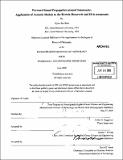Forward sound propagation around seamounts : application of acoustic models to the Kermit-Roosevelt and Elivs seamounts
Author(s)
Kim, Hyun Joe
DownloadFull printable version (41.93Mb)
Other Contributors
Woods Hole Oceanographic Institution.
Advisor
Arthur B. Baggeroer.
Terms of use
Metadata
Show full item recordAbstract
The Basin Acoustic Seamount Scattering Experiment (BASSEX) of 2004 was conducted to measure forward-scattering around the Kermit-Roosevelt Seamount Complex in the Northeast Pacific. The BASSEX experiment was focused on the bathymetric effects on acoustic propagation, in particular, on direct blockage, horizontal refraction, diffraction, and scattering by the seamounts. A towed hydrophone array, with 64 sensors cut for 250Hz (3m spacing), was used to measure the signals transmitted from the aforementioned broadband sources at many locations around the Kermit-Roosevelt and Elvis seamounts. Utilizing the measured broadband signals from the towed array, the size of the shadow zone was obtained. The measured data in the BASSEX experiment strongly support the understanding of the complicated phenomena of sound propagation around the seamounts. In addition, the experimental data could be used to validate current 2D and 3D theoretical models and develop new models to properly realize the sound propagation with such complicated phenomena. In this thesis, the reconciliation between the measured pulse arrivals from the BASSEX experiment and various two-dimensional (2D) and three-dimensional (3D) theoretical models is carried out to investigate the physical characteristics of the sound propagation around seamounts: First, the 2D Parabolic Equation (PE) model and the 2D ray tracing model are used to reconcile each ray arrival with the BASSEX experiment in terms of arrival time and grazing angle. (cont.) We construct a sound speed field database based on the sound speed profiles from the BASSEX experiment, World Ocean Atlas (WOA) 2005, and CTD casts using the objective analysis. Second, 3D broadband sound propagation around a conical seamount is investigated numerically using the 3D spectral coupled-mode model (W. Luo, PhD Thesis, MIT, 2007). Since the calculation of 3D broadband pulses with the spectral coupled-mode model requires extensive computation time, a parallel program is developed with a clustered computing system to obtain results in reasonable time. The validation of the 3D spectral coupled-mode model is performed by a series of comparisons between the various 2D and 3D models for a shallow-water waveguide. The Kermit-Roosevelt seamount is modeled by a simple conical seamount for the 3D model. The computed 3D broadband pulses for the modeled conical seamount are compared with those from the BASSEX experiment and the 2D PE simulation. Through this analysis, we examine the limit of the application of the sound propagation models and improve the efficiency of the 3D sound propagation model using parallel computing to obtain a broadband pulse in a reasonable amount of time.
Description
Thesis (Ph. D.)--Joint Program in Oceanography/Applied Ocean Science and Engineering (Massachusetts Institute of Technology, Dept. of Mechanical Engineering; and the Woods Hole Oceanographic Institution), 2009. Includes bibliographical references (p. 271-277).
Date issued
2009Department
Joint Program in Oceanography/Applied Ocean Science and Engineering; Woods Hole Oceanographic Institution; Massachusetts Institute of Technology. Department of Mechanical EngineeringPublisher
Massachusetts Institute of Technology
Keywords
/Woods Hole Oceanographic Institution. Joint Program in Oceanography/Applied Ocean Science and Engineering., Mechanical Engineering., Woods Hole Oceanographic Institution.